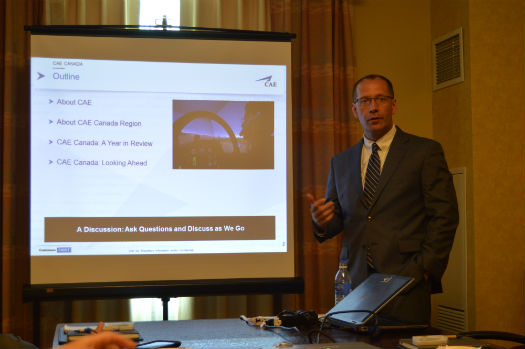Estimated reading time 6 minutes, 54 seconds.
Mike Greenley, vice president and general manager of CAE Canada speaks to media on the eve of CANSEC 2015 about CAE’s burgeoning array of activities. Ken Pole Photo
When Canadian Aviation Electronics Ltd. was founded in 1947 by former Royal Canadian Air Force officer Ken Patrick, he sought to capitalize on his wartime air training experience. Within a week of setting up shop with 18 employees in a hangar at St-Hubert Airport in the eastern suburbs of Montreal, Patrick contracted to build Cold War radar stations above the Arctic Circle. A technological and financial success, it paved the way for what’s branded today as CAE Inc.
Still headquartered at St-Hubert, CAE is so successful that it perhaps should be renamed Canadian Applications Everywhere, reflecting its global presence. It has 8,000 employees at more than 160 locations worldwide, exports more than 90 per cent of its leading-edge flight simulators and other products and services, had annual revenues topping $2.1 billion in the 2014 fiscal year just ended, and an extremely healthy $4.8 billion order book.
Mike Greenley, vice president and general manager of CAE Canada since October 2013, is chairman of the Canadian Association of Defence and Security Industries (CADSI). On the eve of CANSEC 2015, CADSI’s increasingly influential trade show in Ottawa, Greenley, who previously oversaw modelling and simulation for the company’s military business unit, briefed invited media on CAE’s burgeoning array of activities.
“We want to be recognized globally as the training partner of choice,” he said, pointing out that CAE has moved well beyond just flight simulators. “We still deliver simulators, but as a part of a training system. . . . It’s an elevation of profile to be designers and deliverers of training systems that include simulation.”
CAE has been restructured into what Greenley characterized as “three major chunks of business:” defence and security, civil training and, increasingly, health care, where professionals train on realistic simulators before touching actual patients.
For now, however, military training services remain CAE’s core as it trains more than 120,000 pilots annually. Civil training generated approximately $1.3 billion in revenues in fiscal 2014, defence and security business $860 million, and health care nearly $95 million and climbing.
CAE’s core strategy in defence and security is tied to its global presence in flight and maintenance training. Greenley explained that while CAE technology is already used by air forces worldwide, it tracks aircraft manufacturers and air forces aggressively. “Whenever a new air platform comes out, we’ll always be the first one in line that wants to deliver a training system for it.”
But it’s more than just being ready with a simulator and training syllabus. CAE’s approach is “integrated immersive training centres” which involve designing and running a total package which includes the classroom, individual and collective computer-based training, and CAE’s signature full-motion simulators.
Two new high-profile examples are in Ontario: the Air Mobility Training Centre at 3 Wing in Trenton, Ont., and the tactical helicopter training centre at Petawawa, home to the RCAF’s new fleet of Boeing CH-147F Chinooks. “We’re sort of half training system and half operational mission system,” Greenley said, adding that CAE is leveraging its RCAF systems integration “chops” into army, navy and public safety applications.
Asked how a training approach can be translated into an operational platform, he told Skies that the skillsets are similar. “There is some commonality of just good old systems integration and support skills. A modern simulation and training environment can have 10 to 20 million lines of code, and a lot of complexity and networking pulling all that together. Those skillsets are applicable to other mission system environments.”
In Canada, CAE has acquired smaller companies with that level of expertise, including airborne mission systems, electronic warfare systems, information technologies, and in-service support. “We’ve picked up additional subject matter expertise,” Greenley said. “That’s why Canada’s a bit further ahead than other parts of the business.”
CAE is also pushing multi-purpose training centres, like its new joint venture with the government of Brunei, trying to move away from discrete “stovepiped” mission-specific applications. “It’s a higher order of skill that we’re finding ourselves increasingly in,” noted Greenley. “You’ll see us talk about bigger deals as a result; it won’t be just based on the simulator; it’ll be signing a contract to set up and run the training centre and system.”
He said the RCAF’s fixed-wing search and rescue (FWSAR) program, for which the government has just issued a request for proposal and which includes a requirement to set up and run the training, is a typical opportunity. It includes designing the buildings and operating the system for an initial 20 years, as CAE has done at Trenton and Petawawa.
Given its roots, it’s no surprise that CAE’s business is Canadian-driven. Greenley said that Gene Colabatistto, group president of military products, training and services, has a “Canada going to the world” approach. “We do a lot of technology incubation here,” he explained. “We’re very much partnered with government.”
That often involves working first with a Canadian customer, giving CAE a strong case in the intensively-competitive export market. “In any defence business, it’s really important that your own customer has bought from you and you’re partnered with them.”
In that regard, a critical element of CAE’s continuing evolution is its recent acquisition of the NATO flight training business from Bombardier Inc. That enables the company to “step up” from simulators to real aircraft. ”You’ll see us very quickly leverage that to the other countries,” Greenley concluded.

